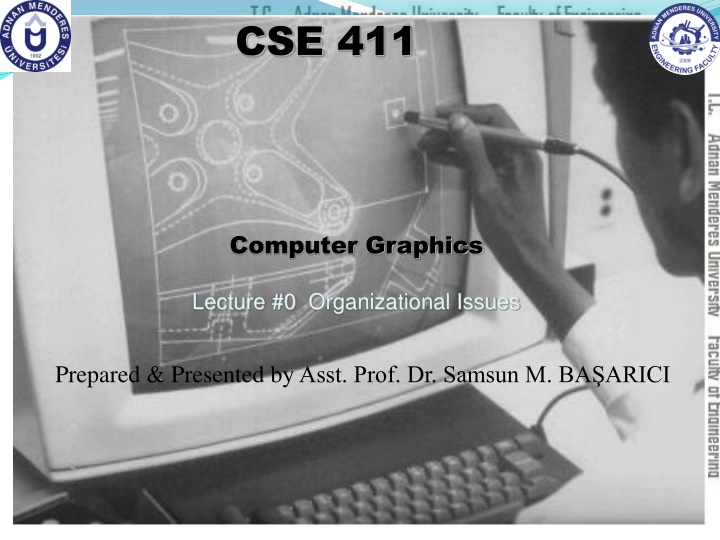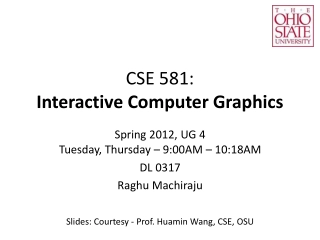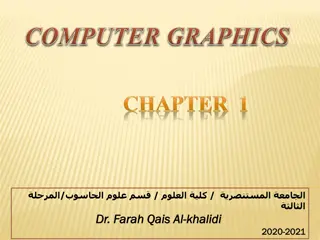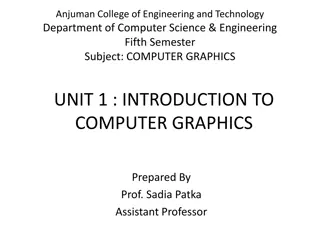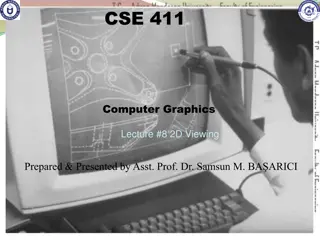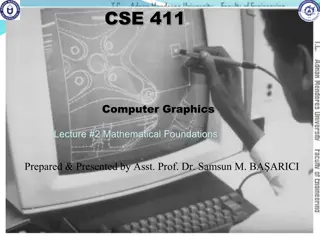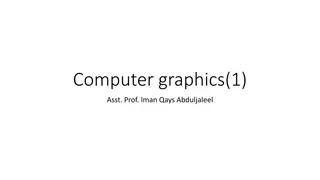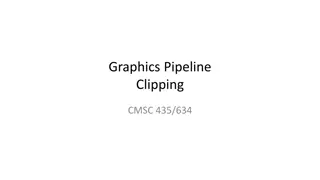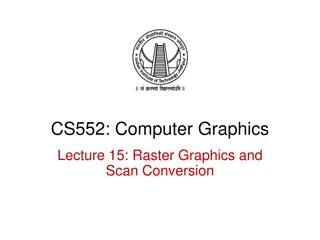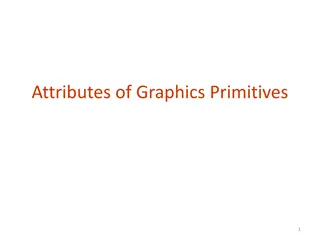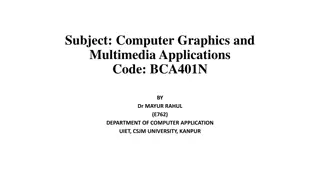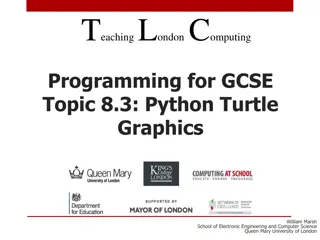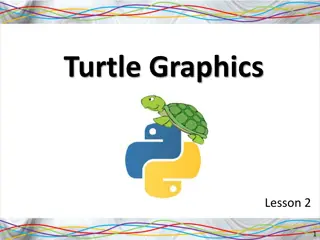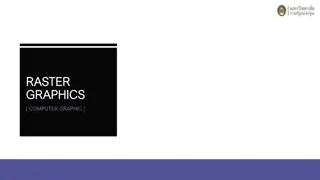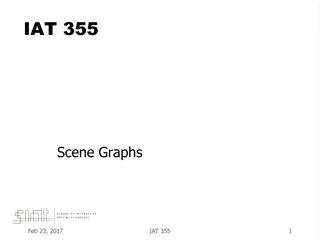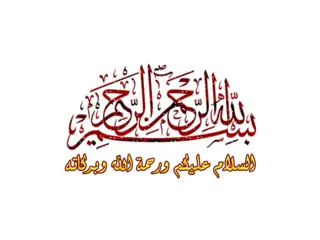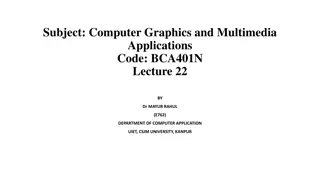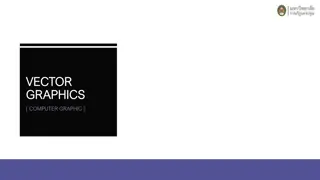Computer Graphics Lecture Organizational Issues
"Prepared and presented by Assistant Prof. Dr. Samsun M. BAARICI. This lecture covers organizational aspects of computer graphics, providing insights into key topics related to the field."
Download Presentation

Please find below an Image/Link to download the presentation.
The content on the website is provided AS IS for your information and personal use only. It may not be sold, licensed, or shared on other websites without obtaining consent from the author.If you encounter any issues during the download, it is possible that the publisher has removed the file from their server.
You are allowed to download the files provided on this website for personal or commercial use, subject to the condition that they are used lawfully. All files are the property of their respective owners.
The content on the website is provided AS IS for your information and personal use only. It may not be sold, licensed, or shared on other websites without obtaining consent from the author.
E N D
Presentation Transcript
CSE 411 Computer Graphics Lecture #0 Organizational Issues Prepared & Presented byAsst. Prof. Dr. Samsun M. BA ARICI
About this Course Course Code Course Hour/Week Course Title Semester ADU Credit ECTS Theory 2 Practice 2 Introduction to Computer Applications CSE 411 Fall 3 6 Course Type 1. Compulsory Courses 1.1. Programme Compulsory Courses 1.2. University Compulsory Courses (UFND) 1.3. Y K (Higher Education Council) Compulsory Courses 2. Elective Courses 2.1. Program Elective Courses X 2.2. University Elective Courses 3. Prerequisites Courses 3.1. Compulsory Prerequisites Courses 3.2. Elective Prerequisites Courses Organizational Issues 2
About this Course (Cont.) Language of Instruction English Associate Degree (Short Cycle) Undergraduate (First Cycle) Graduate (Second Cycle) Doctoral Course (Third Cycle) Level of Course Special Pre-Conditions of the Course (compulsory) None Knowledge of computer programming and basic data structures, such as arrays, pointer lists, files, and record organization. Also some basic knowledge in analytic geometry, linear algebra, vector and tensor analysis, complex numbers, basic calculus, and numerical analysis is helpful. Special Pre-Conditions of the Course (recommended) Mail: sbasarici@adu.edu.tr Web: http://akademik.adu.edu.tr/fakulte/muhendislik /personel/sbasarici/anasayfa Course Instructor(s) Dr. Samsun M. Ba ar c Organizational Issues 3
Main Objective(s) of this Course In this course it is intended to introduce the basic concepts of computer graphics and provide a foundation for implementing commonly used algorithms. computer graphics Organizational Issues 4
Learning Outcomes of this Course Upon successful completion of this course, students will Understand the basic concepts of graphics hardware and software Develop computer graphics programs using OpenGL Be able to add 2D and 3D graphics to their applications Be able to write programs to display 2D and 3D data Have the basic knowledge and ability to follow new topics in computer graphics field Organizational Issues 5
Course Content This fundamental including an overview of graphic systems, output primitives, geometric transformations, viewing techniques, visible surface detection, rendering methods, color models and rendering. course provides topics students computer with graphics the in Organizational Issues 6
Resources 1) Donald Hearn, M. Pauline Baker, Warren R. Carithers, Computer Graphics with OpenGL, 4th Edition ; Pearson, 2011, ISBN: 978- 0132484572 (HB) Required Course Material (s) /Reading(s)/Text Book (s) 2) Jonas Gomez, Luiz Velho, Maria Costa Sousa, Computer Graphics: Theory and Practice , CRC Press, 2012, ISBN: 978-1568815800 (GVS) 3) Lecture Notes Sumanta OpenGL: From Theory to Experiments , CRC Press, 2010, ISBN: 978-1439846209 Guha, Computer Graphics Through Recommended Course Material (s)/Reading(s)/Other Jeffrey J. McConnell, Computer Graphics: Theory into Practice , Jones & Bartlett Pub., 2005, ISBN: 978- 0763722500 Organizational Issues 7
Resources (cont.) Kelvin Sung, Peter Shirley, Steven Baer, Essentials of Interactive Computer Graphics: Implementation , CRC Press, 2008, ISBN: 978- 1568812571 Concepts and Richard S. Wright, Nicholas Haemel, Graham Sellers, Benjamin Lipchak, Comprehensive Tutorial and Reference , Addison- Wesley, 2010, ISBN: 978-0321712615 OpenGL SuperBible: Recommended Course Material (s)/Reading(s)/Other Edward Angel, Interactive Computer Graphics. A Top- Down Approach Using OpenGL , Addison-Wesley, 2005, ISBN: 978-0321312525 http://www.glprogramming.com/ Otherresourceswill beannounced during thecourse Organizational Issues 8
Course Schedule (Weekly) Methodology and Implementation (theory, practice, assignment etc) Week Topics Preliminary Preparation Introduction and overview, introduction to OpenGL HB Ch. 1-3 & App. C, GVS Ch. 1 C++ (Refreshment), Installing & using OpenGL (first steps) C++, Installing & using OpenGL (cont.) 1 Mathematics for CG HB App. A, GVS Ch. 2-4 2 Graphics Output Primitives HB Ch. 4, GVS Ch. 7 (partly) Drawing simple primitives 3 Attributes of Graphics Primitives HB Ch. 5-6 Drawing simple primitives (cont.) Assignment 1 Creating menus, submenus etc. Drawing 2D shapes and performing transformations 4 Interactive Input Methods HB Ch. 20 5 HB Ch. 7, GVS Ch. 3 2D Geometric Transformations 6 3D Geometric Transformations HB Ch. 9 Drawing 3D shapes like cubes, blocks etc. and performing transformations Assignment 2 7 Organizational Issues 9
Course Schedule (Weekly) (Cont.) Methodology and Implementation (theory, practice, assignment etc) Preliminary Preparation Week Topics MIDTERM EXAM 8 2D Viewing HB Ch. 8 Implementing 2D clipping and transforming algorithms Implementing 3D clipping and transforming algorithms Generating a scene using polyhedra Assignment 3 Displaying a polyhedron with selected faces removed Illuminating the scene created with polyhedral Assignment 4 Creating and changing the transparency of a scene & implementing ray tracing methods 9 3D Viewing HB Ch. 10 10 3D Object Representations HB Ch. 13-15, GVS Ch. 8 & 10 11 Visible Surface Detection HB Ch. 16, GVS Ch. 13 12 Illumination & Rendering HB Ch. 17 & 21, GVS Ch. 14 & 18 13 Illumination & Rendering (cont.) HB Ch. 17 & 21, GVS Ch. 14 & 18 (cont.) 14 Project presentation 15 16 FINAL EXAM Organizational Issues 10
Assessment (tentative) SemesterActivities/ Studies NUMBER WEIGHT in % Mid- Term Attendance Quiz Assignment (s) Project Laboratory Field Studies (Technical Visits) Presentation/ Seminar 1 - 4 5 1 - - - 15 - 20 10 15 - - - Practice (Laboratory, Virtual Court, Studio Studies etc.) - - Other (Placement/Internship etc.) - - TOTAL 60 Contribution of Semester Activities/Studies to the Final Grade 60 Contribution of Final Examination/Final Project/ Dissertation to the Final Grade 1 40 TOTAL 100 Organizational Issues 11
Assessment (Cont.) Final Grades will be determined according to the Adnan Menderes University Associate Degree, Bachelor Degree and Graduate Degree Education and Examination Regulation Organizational Issues 12
Responsibilities of the Students Obtaining the text book(s) Coming to the course with a good preparation Completing the exercises with individual efforts unless told otherwise Following the rules set by the responsibles for the course and the implementation/lab. studies HONESTY !!! Organizational Issues 13
Plagiarism Plagiarism will not be tolerated Projects without references: a penalty of 20% Submitting your own work that has been earlier submitted to satisfy the requirements of another course is (self)-plagiarism (also called double dipping) Copying a journal article or a section of a book or code from an article or book and submitting it as your own is plagiarism Organizational Issues 14
Plagiarism (Cont.) Using significant ideas from someone else, but putting them in to your own words and not acknowledging the source of the ideas is plagiarism Copying an essay, code, work etc. from another student and submitting it as your own is plagiarism And PLAGIARISM is THEFT So don t steal (Nobody likes thieves) Organizational Issues 15
